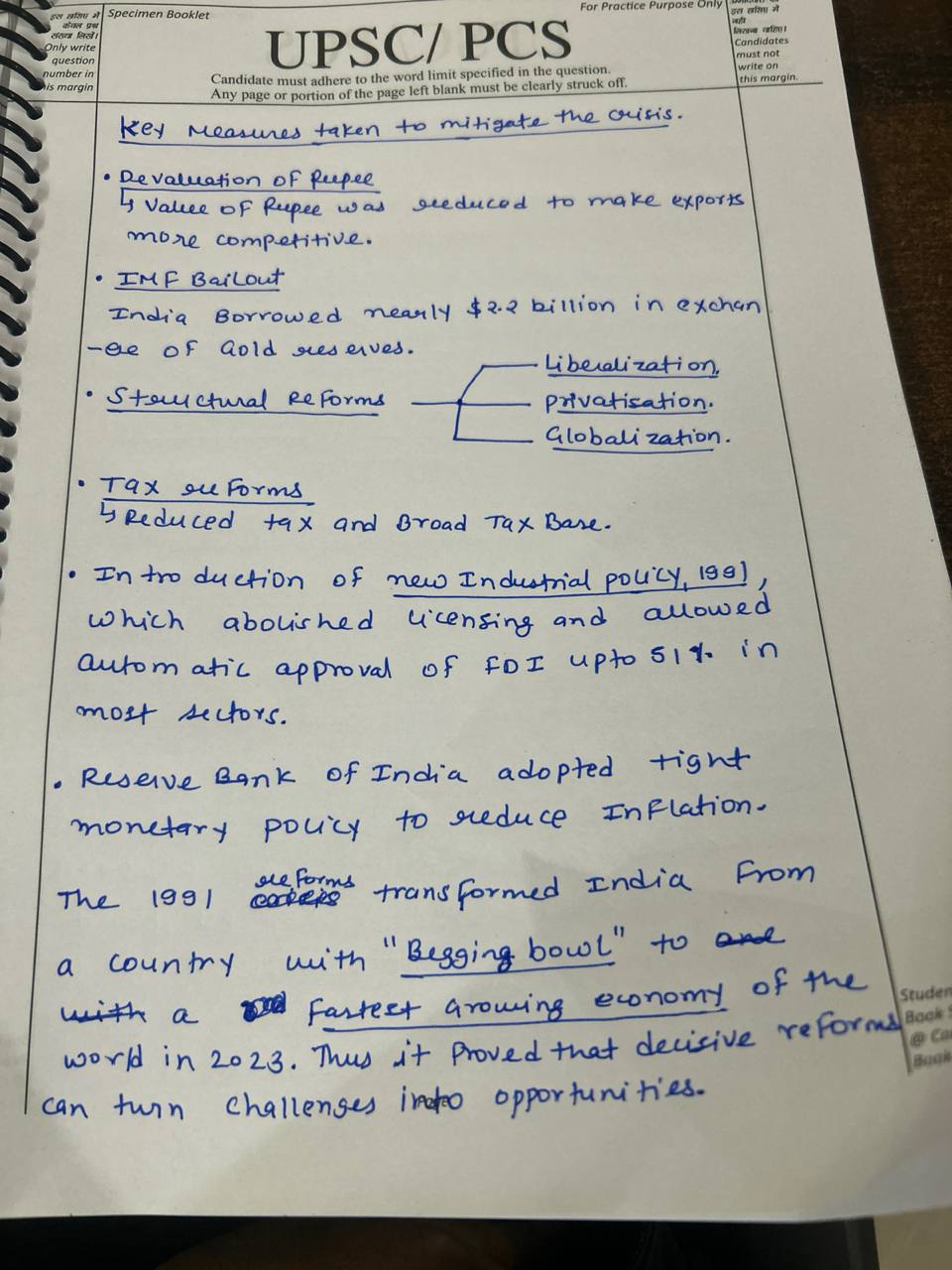Examine the government’s initiatives to improve financial inclusion and credit availability, especially for the underprivileged segments of the population. This includes the expansion of banking and microfinance networks, the Jan Dhan Yojana, and the Pradhan Mantri Mudra Yojana. Additionally, determine ...
Government Initiatives to Reform the Taxation System The Indian government has undertaken significant reforms in the taxation system, notably through the implementation of the Goods and Services Tax (GST) and various measures to improve tax compliance and administration. These initiatives aim to enhRead more
Government Initiatives to Reform the Taxation System
The Indian government has undertaken significant reforms in the taxation system, notably through the implementation of the Goods and Services Tax (GST) and various measures to improve tax compliance and administration. These initiatives aim to enhance the efficiency and transparency of the tax regime. Here’s an analysis of these reforms and their impact:
Implementation of the Goods and Services Tax (GST):
Objective: GST was introduced to simplify the tax structure, eliminate cascading taxes, and create a unified indirect tax system across India.
Key Features:
Single Tax Structure: GST subsumes multiple indirect taxes such as VAT, Service Tax, and Excise Duty into a single tax regime.
Input Tax Credit: Allows businesses to claim credit for the tax paid on inputs, thereby reducing the cascading effect of taxes.
Technology-Driven: GST implementation involves a robust online platform for tax filing, payment, and compliance.
Recent Examples:
E-Way Bill System: Introduced to streamline the movement of goods and ensure compliance, the e-way bill system has helped in reducing tax evasion and improving logistics efficiency.
GST Network (GSTN): Provides a digital platform for filing returns and managing compliance, which has been instrumental in automating and standardizing the tax process.
Impact:
Efficiency: GST has simplified the tax structure, reduced the complexity of compliance, and streamlined the process of tax collection. The unified tax regime has reduced the multiplicity of taxes and ensured a seamless flow of credit across the supply chain.
Transparency: The introduction of a digital platform for GST compliance has improved transparency and reduced the scope for tax evasion. The availability of real-time data has enhanced monitoring and enforcement capabilities.
Efforts to Improve Tax Compliance and Administration:
Objective: To enhance tax compliance, reduce evasion, and improve the efficiency of tax administration.
Key Initiatives:
Digitalization of Tax Services: The e-filing of Income Tax Returns and e-payment of taxes have simplified tax compliance for individuals and businesses.
Faceless Assessment and Appeals: Launched to minimize human intervention and ensure impartiality, faceless assessment aims to reduce corruption and enhance transparency.
Implementation of the Income Tax Act (Amendment) 2021: This includes provisions for reducing litigation, increasing transparency, and improving the efficiency of the tax administration process.
National Anti-Profiteering Authority (NAA): Established to ensure that the benefits of reduced tax rates under GST are passed on to consumers rather than being absorbed by businesses.
Recent Examples:
Tax Information Network (TIN): The TIN platform has facilitated the electronic filing of tax returns and the issuance of Tax Deducted at Source (TDS) certificates, improving the efficiency of tax collection and compliance.
GST Compliance Rating System: Implemented to evaluate and incentivize businesses based on their compliance with GST regulations, promoting adherence and reducing tax evasion.
Impact:
Efficiency: The digitalization of tax services has significantly reduced the time and effort required for tax compliance. Faceless assessments and appeals have streamlined administrative processes and reduced the burden on taxpayers.
Transparency: Improved transparency through digital platforms and faceless assessments has reduced opportunities for corruption and increased trust in the tax system. The data-driven approach has enhanced the accuracy of tax assessments and reduced disputes.
Evaluation of Impact
Efficiency and Simplification:
GST: The GST has simplified the indirect tax structure and created a more efficient system by integrating various taxes into a single framework. The input tax credit mechanism has reduced the cascading effect of taxes, benefiting businesses and consumers alike.
Digitalization and Faceless Services: These initiatives have streamlined tax administration, reduced paperwork, and minimized human intervention, leading to a more efficient and taxpayer-friendly system.
Transparency and Compliance:
GST Network and Compliance Rating: The GST network has enhanced transparency by providing a digital platform for compliance. The GST compliance rating system incentivizes businesses to adhere to tax regulations and reduces the scope for evasion.
Faceless Assessments: These have improved the fairness and transparency of tax assessments by minimizing opportunities for biased decision-making and corruption.
Recent Challenges and Areas for Improvement:
Implementation Issues: GST has faced challenges such as frequent changes in rates and technical glitches in the GSTN, which have impacted compliance and business operations.
Compliance Burden: Despite improvements, small businesses often struggle with the complexity of GST compliance. Efforts to simplify the process further and provide support to small enterprises are ongoing.
Conclusion
The Indian government’s initiatives to reform the taxation system, including the implementation of GST and improvements in tax compliance and administration, have significantly enhanced the efficiency and transparency of the tax regime. These reforms have simplified tax processes, reduced tax evasion, and created a more equitable and streamlined system. Continued efforts to address implementation challenges and further streamline compliance processes will be crucial for sustaining and enhancing the benefits of these reforms.
See less


The Indian government has implemented several key policies and measures aimed at enhancing financial inclusion and access to credit, particularly for marginalized sections of the population. Let's evaluate some of these initiatives and their impact: 1. Jan Dhan Yojana: Objective: The Pradhan MantriRead more
The Indian government has implemented several key policies and measures aimed at enhancing financial inclusion and access to credit, particularly for marginalized sections of the population. Let’s evaluate some of these initiatives and their impact:
1. Jan Dhan Yojana:
Objective: The Pradhan Mantri Jan Dhan Yojana (PMJDY), launched in 2014, aimed to provide financial services such as savings accounts, remittances, credit, insurance, and pension to the unbanked population.
Impact:
Increased Financial Inclusion: By 2023, over 43 crore Jan Dhan accounts had been opened, significantly increasing the percentage of financially included households.
Direct Benefit Transfer (DBT): Enabled direct transfer of subsidies and benefits to beneficiaries, reducing leakages.
Access to Credit: Facilitated easier access to formal credit through overdraft facilities and micro-insurance.
2. Pradhan Mantri Mudra Yojana (PMMY):
Objective: Launched in 2015, PMMY aims to provide funding to micro and small enterprises by offering loans up to Rs. 10 lakh to non-corporate, non-farm small/micro enterprises.
Impact:
Enhanced Credit Access: PMMY has disbursed loans to millions of small entrepreneurs, promoting entrepreneurship and self-employment.
Job Creation: Supported the growth of small businesses, leading to employment generation, especially in rural and semi-urban areas.
Reduction in Informal Sector Borrowing: Reduced reliance on informal sources of credit which often charge exorbitant interest rates.
3. Expansion of Banking and Microfinance Networks:
Objective: The government has focused on expanding the reach of banking services and microfinance institutions (MFIs) to underserved areas.
Impact:
Increased Accessibility: Expansion of bank branches and BC (Business Correspondent) networks has brought banking services closer to rural and remote areas.
Microfinance Penetration: MFIs have played a crucial role in providing small loans and financial services to economically weaker sections, especially women and rural entrepreneurs.
Assessment of Impact on Financial Security and Entrepreneurship:
Financial Security: These initiatives have contributed significantly to enhancing financial security among marginalized populations by providing them with access to formal banking services, insurance, and pension schemes. This has reduced their vulnerability to economic shocks and enhanced their ability to save and invest.
Entrepreneurship: PMMY, in particular, has boosted entrepreneurship by providing timely and affordable credit to small businesses and startups. This has fostered a culture of entrepreneurship, especially in rural areas, leading to job creation and economic empowerment.
Challenges and Areas for Improvement:
Awareness and Education: Ensuring that beneficiaries understand the benefits and proper utilization of these services remains a challenge.
Sustainability: Continuous monitoring and support are essential to ensure the long-term sustainability of these initiatives and to prevent misuse or defaults.
Conclusion:
Overall, the government’s policies and measures such as Jan Dhan Yojana, PMMY, and the expansion of banking and microfinance networks have had a positive impact on improving financial security and fostering entrepreneurship among marginalized sections of the population in India. These initiatives have significantly contributed to inclusive economic growth and empowerment, although ongoing efforts are needed to address challenges and ensure sustainable outcomes.
See less